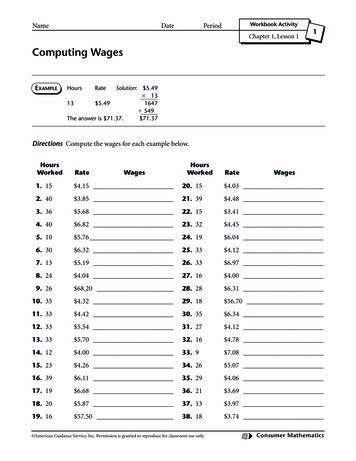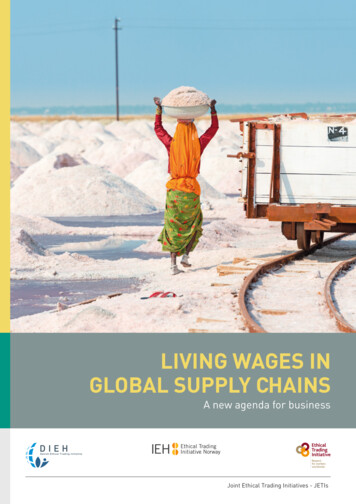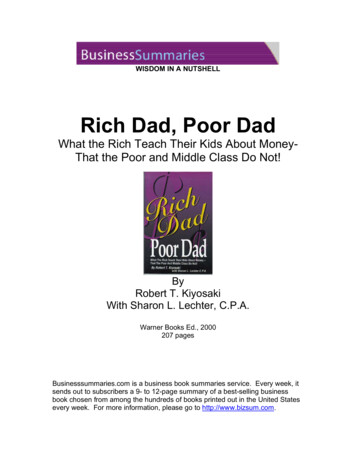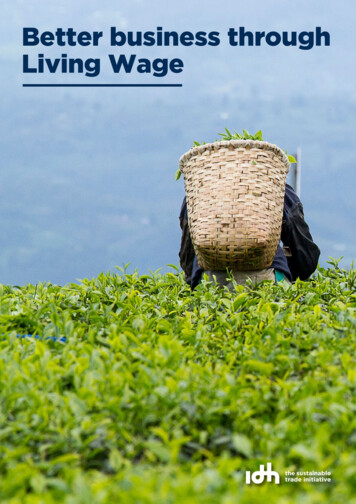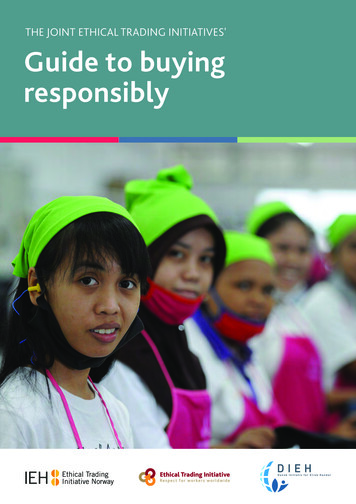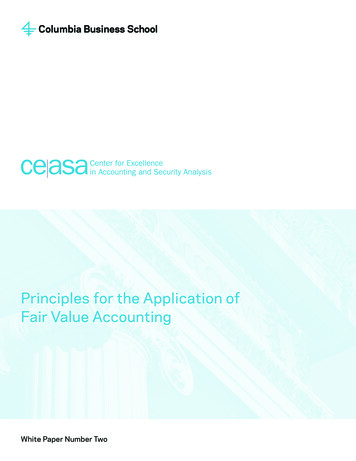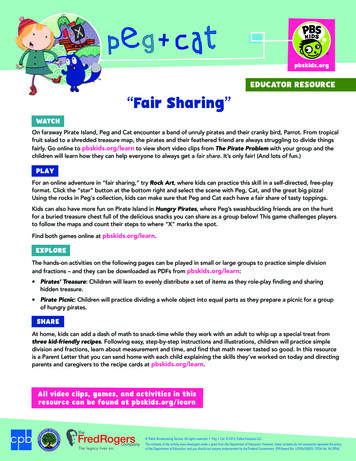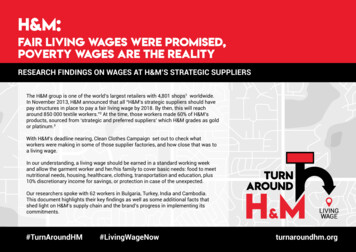
Transcription
H&M:fair living wages were promised,poverty wages are the realityRESEARCH FINDINGS ON WAGES AT H&M’S STRATEGIC SUPPLIERSThe H&M group is one of the world’s largest retailers with 4,801 shops1 worldwide.In November 2013, H&M announced that all “H&M’s strategic suppliers should havepay structures in place to pay a fair living wage by 2018. By then, this will reacharound 850 000 textile workers.”2 At the time, those workers made 60% of H&M’sproducts, sourced from ‘strategic and preferred suppliers’ which H&M grades as goldor platinum.3With H&M’s deadline nearing, Clean Clothes Campaign set out to check whatworkers were making in some of those supplier factories, and how close that was toa living wage.In our understanding, a living wage should be earned in a standard working weekand allow the garment worker and her/his family to cover basic needs: food to meetnutritional needs, housing, healthcare, clothing, transportation and education, plus10% discretionary income for savings, or protection in case of the unexpected.Our researchers spoke with 62 workers in Bulgaria, Turkey, India and Cambodia.This document highlights their key findings as well as some additional facts thatshed light on H&M’s supply chain and the brand’s progress in implementing ndhm.org1
Summary of findingsPOVERTY WAGES COUPLED WITH FIERCE LABOUR LAW AND HUMAN RIGHTS VIOLATIONS No interviewed workers earnanything near a living wage.The Indian and Turkish workers interviewed earn about a third of the estimated base living wage. InCambodia, the respondents earn almost half a base living wage. In Bulgaria, interviewees are paidless than 10% of a base living wage for the regular working hours. Many interviewed workers and theirWORKERS’ WAGE AS A SHARE OF A LIVING WAGEfamilies live below the poverty line. Overtime hours reported by theworkers often exceed the legalmaximum. Sunday work is common amonginterviewed workers. Overtime is reportedly not alwayspaid in line with legal requirements. Hardly any interviewed workersknow how their wages arecalculated. Workplace fainting appears tobe commonplace in multipleresearched e existing governmental and EU poverty thresholds rank considerably higher than the legal minimumwage and workers’ actual remuneration in Bulgaria and Turkey. The interviewed H&M workers inBulgaria earn less than two thirds of the EU’s poverty threshold despite working 80 hours a week!WORKERS IN BULGARIA EARN LESS THAN TWO THIRDS OF THE EU’S POVERTY THRESHOLD Workers in all researched factoriesfear organizing in independentunions. 98Net wage, regular working hours 259Net wage, with overtime and allowances 375EU-SILC poverty threshold2
Workers are forced to work excessive hours forsheer survival. The number of overtime hoursin three out of the six researched factoriesoften exceeds the legal maximum. Workingon Sundays frequently occurs in all countries.Overtime in H&M’s ‘gold supplier’ in Bulgariareached an outrageous level during theresearch period.In Bulgaria, none of the respondents earnthe legal minimum wage in a standard workweek and no worker was paid the appropriateovertime premium.A portion of all interviewees in India and Turkeyonly get paid the legal minimum wage if theywork overtime and finish their quota. This notonly violates the legal requirement that thestatutory minimum wage must be earned inregular working hours; but ILO defines this asforced labour.A number of the interviewees in India donot earn the legal minimum wage even withovertime.“THE WAGES ARE SO LOW THATWE HAVE TO WORK OVERTIMEJUST TO COVER OUR BASICNEEDS.(A worker in India)”While workers in all the factories fear organisingin independent unions, union activities havebeen actively suppressed in two of the sixresearched factories. Researchers in all fourcountries emphasized that there are routineFreedom of Association violations in H&Msuppliers, which contributes substantially tokeeping wages low.workers’ rights at four of H&M “best-in-class”suppliers in Cambodia”.4 While irregularitiesrelated to overtime, overtime payment,disciplinary wage deductions remain the same,according to interviewees, the excessive use ofshort-term contracts and the health situationof workers appear to have deteriorated.PAY ALIVINGWAGE21FOOD3Most respondents do not know how their wageis calculated.In all four countries, irregularities happen withregards to disciplinary wage deductions andovertime payment.Poverty wages, constant pressure, additionalhousehold and care work for women, badair quality and high temperatures in theworkplace result in fainting being a commonocurrence in the factories in Bulgaria,Cambodia and India.In Cambodia, our research did not revealimprovements on a number of issues that werealso investigated for the 2016 report “When“best” is far from good enough. Violations 7SAVINGS3
BULGARIAThe case of Koush ModaAN H&M ‘GOLD SUPPLIER’TO SAVE MONEY, WE BUY“SECONDHAND CLOTHES –SOMETIMES H&M CLOTHES!”(A worker in Bulgaria)Workers are pressured to work 12hours per day, seven days a week, andnever receive the statutory minimumwage within standard working hours.Workers reported that they have to workovertime just to earn the statutory minimumwage, but even doing overtime does notnecessarily mean they will receive theminimum wage. Workers reported that theyhave to work 12 hours per day, seven daysa week. Sometimes they work 24 hours ina row, plus the next day’s shift. At the timeof research, this amounted to 44 hours ofovertime per week (4 hours per weekday 2 x 12 hours during weekends). This is farbeyond any legal limits for overtime and forconsecutive working hours.WE DO NOT HAVE A CHOICE.“THEREIS NO OTHER WORKAROUND HERE.”Do workers working 44 overtime hours a weekearn the statutory minimum wage?Bulgarian labour law determines that theovertime premium must be 50% on regularworking days, 75% on weekends, and 100%during official holidays. The workers with thehighest salary in the factory are said to receiveabout 900 BGN net (459 EUR/549 USD). For aBulgarian garment worker, this is unusually high,but this includes payment for 44 overtime hoursper week. Within the regular working hours ittranslates to net earnings of only 341 BGN/174EUR/208 USD, which is still below the statutoryminimum wage (400 BGN/204 EUR/244 USDnet).5 For the average reported net salary of507 BGN (259 EUR/309 USD), the wage earnedwithin regular working hours is 192 BGN/98EUR/117 USD per month in average 6 with anhourly wage of 1 BGN /0,51 EUR/0,61 USD.One worker reported to not have received alabour contract. According to the interviewees,the factory also employs home-based workers,to repair defective clothes, for instance. Theirworking conditions could not be established.Workers in the factory reported that labourinspection visits were preceded by themanagement coaching workers on how torespond. In addition, management blockedattempts for unionization.WORKERS’ WAGEAS A SHARE OF ALIVING WAGE9%4
YOU ENTER THE FACTORY AT 8 IN THE MORNING, BUT YO“NEVERKNOW WHEN YOU WILL BE ABLE TO LEAVE. SOMETIMESWE GO HOME AT 4 AM.”(A worker in Bulgaria)Wage Ladder BULGARIA719298USD117BGNEURAverage net salary of interviewed workers within the regular working hours(without overtime, calculated back from overall net wage) 8400204USD 244BGNEURLegal min net wage during time of research (Mar - May 2018) 9507259USD 309BGNEURAverage net salary of interviewed workers including overtime and allowances528269USD 318BGNPoverty line: 60% of the average net salary in the country 2017 10EUR737375USD 429BGNPoverty line for a family 2017: EU-SILC At-risk-of-poverty threshold 11EUR800407USD 465BGNTrade union demand for a legal minimum wage: confederation KNSB / CITUB 2017 12EUR1,000511USD 597BGNEURTrade union demand for a legal minimum wage: confederation Podkrepa 2017 132,1801,112USD 1,330BGNEUREstimated base living wage accordingto interviewed workers 2018 142,3401,192USD 1,471BGNEURTrade union calculation for a minimumcosts for a decent life (a living wage):confederation KNSB / CITUB, April 2018 155
TURKEYThe case of Pameks GiyimISTANBUL BRANCH, AN H&M ‘GOLD SUPPLIER’Workers are afraid to complainabout working conditions.Since the fatal incident in this factory in2009, when nine women workers died,the pressure on workers has increased.They are afraid to complain about workingconditions for fear of getting fired.Therefore,researchers struggled more than usual tofind workers willing to speak with them.Workers reported contractual wage justabove the minimum wage; they earned 1,750TRY / 365 EUR per month on average, whilethe net minimum wage was 1,603 TRY / 334EUR. These workers are often the families’only breadwinners.Wage ladder Turkey1,603334USD 414TRYEURLegal min net wage during time of research (Mar - May 2018)1,750365USD 452TRYEURAverage net salary of interviewed workers within the regular workinghours (without overtime, according to contracts)1,957408USD 505Average net salary of interviewed workers including overtimeand allowances1,893416USD 491Trade union demand for a legal minimum wage: confederation Türk-İş 17TRYEURTRYEUREUR5,2501,333USD 1,496“Poverty threshold” for a family,June 2017 195,3311,133USD 1,403Trade union calculation for a basecosts for a decent life (a living wage):confederation Türk-iş, February 2018 20TRYWorkers reported that they work, onaverage, 23 overtime hours per week,but there are weeks at a time when theyare expected to work 45 overtime hours.They work “every day from 8.00 AM untilmidnight”. This violates Turkish law (legalmaximum: 78 hours a month, 270 hoursa year), as does the lack of payment ofthe legal overtime premium that was alsoreported by the workers. Interviewees alsoreported that disciplinary wage deductionsare broadly applied.WORKERS’ WAGEAS A SHARE OF ALIVING WAGE16TRYEUR6,1301,182USD 1,414TRYEUR29%Estimated base living wage accordingto interviewed workers, May 2018 21SOMETIMES I AM NOT ABLE TO SEE MY FAMILY“MEMBERS.I COME HOME AND CRASH ON MY BED.”(A worker in Turkey)6
CAMBODIAthe case of EASTEX GARMENT CO., LTD. ANDSEDUNO INVESTMENT CAMBO FASHION CO., LTD.H&M ‘PLATINUM SUPPLIERS’Ever more precarious contracts,routine overtime without sufficientcompensation, disciplinary wagedeductions, and deterioratingworkers’ health.We conducted research on two of the fourfactories investigated in the 2016 report “When“best” is far from good enough. Violations ofworkers’ rights at four of H&M “best-in-class”suppliers in Cambodia”.The aim was to comparethe situation and check whether there had beenany improvement to the wage level and violationsreported then.Just like in 2016, all interviewed workers gotat least the minimum wage per month beforeovertime. In comparison with CCC’s 2016research, which reported an average wage of 173USD without overtime, the reported wage withoutovertime rose by 29%. This is mainly due to anincrease in the statutory minimum wage by 21%(from 140 USD in 2016 to 170 USD in 2018). Thisminimum wage hike was the result of severalyears of labour unrest and wage struggles.7
WORKERS’ WAGEAS A SHARE OF ALIVING WAGE46%The difference between reported wages with and without overtime (63 USD average) is lower thanwhat the average overtime hours would require as additional remuneration (66 USD) based on themandatory overtime premium of 50%.23 This gap increases when considering work on Sundayswith an overtime premium of 100%. All interviewed workers had to work an average of 3.4 Sundaysduring the previous three-month period. The only possible conclusion is that overtime payment issometimes not compliant with the law.Two thirds of respondents have fainted at work and all workers have had to receive glucose dripsbecause of dehydration. The health of workers seems to have worsened compared to 2016.Moreover, the issue of short-term contracts has deteriorated. A vast majority (85%) of respondents saidtheir labour contract is valid for only three to six months. In 2016 more workers had unlimited durationcontracts. Cambodian law allows any fixed term contract in the first two years of service. Two thirdsof respondents with short-term contracts have been employed for two or more years in the factory.After this time period, the law requires a modification of their employment into an unlimited durationcontract.All workers reported disciplinary wage deductions, which is illegal according to articles 126–129 ofthe Cambodian labour code and not permitted according to H&M’s code of conduct.As in some otheraspects, the situation remains unchanged compared to 2016.ILO found that the development of the realminimum wage (as an inflation-adjusted nominalminimum wage) shows a much smaller increase,if any at all, prior to 2016.22 That means that theminimum wage increase barely compensated forthe inflation in the years before 2016.Concerning overtime, the situation remainsunchanged: Workers reported regularly working10 hours a day, i.e. eight standard hours plusthe legally possible two overtime hours despitethe fact that Cambodian labour law saysovertime should only occur in exceptional andurgent cases. The 41 overtime hours, whichrespondents worked on average, do suggestregularity of its occurrence; workers workovertime on at least 20 of the 26 standardworking days per month (six days a week).Wage ladder cambodia 24KHR683,482EUR146USD170KHRLegal minimum wage during time of research (June 2018, minimum wage set on 5 October 2017) - Onlyworkers in garment and footwear sectors have a legally mandated minimum wage 25998,319EUR 171USD 207KHRDemand for a legal minimum wage: Cambodia LabourFederation, 1 May 2018 26896,568EUR 190USD 223KHRAverage net/gross salary of interviewed workers without overtime1,149,860EUR 244USD 286Average gross salary of interviewed workers including overtimeKHR1,939,606EUR 410USD 477Asia Floor Wage for 2017 278
INDIAThe case of two H&M ‘gold suppliers’Numerous irregularities in wage andovertime practices.Workers in India asked for their factories not to beidentified.In one of the two factories, workers reported that they donot earn the minimum wage even after working overtime.Three quarters of the workers interviewed reporteddisciplinary wage deductions.During the time of the research, the working hours in onefactory were 11 hours per day or more, whereas the legalmaximum is 10 hours. Often there is no evening break. Theovertime practices in this factory break the overtime law toan even greater extent than the other researched factories.Some of the interviewees reported working on a piece-ratebasis and being paid in cash. These interviewees workedalmost every Sunday - so seven days a week - and werenot provided with payslips. For the rest of respondents,overtime is sometimes paid in cash and not properlyreflected in payslips. Additionally, workers told researchersthat the legally required premium for overtime is not paid,for instance for Sunday work (it should be double thenormal wages).Wage ladder India28INR7,531/7,339EUR 94/91USD 116/113Legal min net wage during time of research (Mar - May 2018) for grade I tailor7,776EUR 97USD 120INR9,245115USD 142INREURAverage net salary of interviewed workers without overtimeAverage gross salary of interviewed workers including overtimeINR18,000EUR 224USD 277Trade union demand for a legal minimum wage: Centreof Indian Trade Unions (CITU) and the All-India TradeUnion Congress (AITUC) 29INR22,000EUR 297USD 340WORKERS’ WAGEAS A SHARE OF ALIVING WAGEAsia Floor Wage for 2017 3035%According to respondents, there is no union or workerrepresentation in any of the two factories.9
INDIAThe case of Shahi Exports Pvt Ltd.BANGALORE, AN H&M ‘GOLD SUPPLIER’This case was initially beyond the scope of our field research, butcame to our attention through the workers’ request for urgentassistance.In early 2018, workers of Shahi’s Unit 8 in Bangalore sufferedphysical assaults, death threats, and insults based on caste statusand religious beliefs. There were threats of mass dismissals and15 workers were suspended.31 “The violations occurred ( ) in thecourse of a deliberate effort by Shahi to repress the organization ofa union at the factory and, relatedly, prevent an increase in garmentworkers’ wages. ( ) Shahi Exports Pvt. Ltd. is India’s largest garmentmanufacturer with more than US 850 million in annual revenue. ( )Workers at the Shahi Unit 8 factory, however, only earn an estimatedaverage wage of roughly US 0.62 or 0.57 EUR per hour (ibid, page 3).Clean Clothes Campaign and Asia Floor Wage Alliance (AFWA) activelysupported KOOGU’s demands (and the Worker Rights Consortium’srecommendations for corrective action) towards brands and retailerssourcing from Shahi including H&M. This led to negotiations for aMemorandum of Understanding,32 which aims to take up collectivebargaining on wage and working conditions. However, while a meetingbetween the union and the management has taken place, collectivebargaining has not started yet. Clean Clothes Campaign, WorkersRights Consortium and Asia Floor Wage Alliance expect H&M toactively continue to ensure freedom of association throughout Shahiunit 8, which includes ensuring workers’ rights to form and join unionsand engage in collective bargaining. Secondly, the retailer giant shouldpro-actively engage in informing workers that its gold suppliersrespect freedom of association in all its units across the country.10
A day in the life ofa garment worker in IndiaI AM THE ONLY EARNER IN THE“FAMILY.I HAVE TO LOOK AFTERMY CHILDREN’S EDUCATION. I HAVETO WORK HARD TO GIVE THEM ABETTER FUTURE, SO THAT THEYDO NOT HAVE TO WORK INTHE GARMENT FACTORY LIKE ME.”A., 40 years old, is married, has three children andworks in a garment factory. She gets up at 4.30AM to do household work and to prepare foodfor her family. To reach the factory on time shefrequently skips breakfast. She stated that evenif she is just a minute late, she loses her wage fora whole hour. She starts her day at the factory at7.30 in the morning. On a normal day, she getsdone between 6.30 and 7 in the evening, but sheis often made to work extra hours.She has fainted at the factory twice. Once sherecovered in a few minutes, but the other timefellow workers had to take her to the hospitalbecause she had hit a machine and was bleedinginternally.She is the single breadwinner in her family,meaning that she takes care of the five familymembers with a wage of a mere 6000 INR/85EUR per month.11
What consequences do poverty wageshave on workers’ nutrition and health?A GENDERED SITUATIONIn all the researched countries the longworking hours, often every day of theweek, combined with high work pressure,hot temperatures and a noisy and poorlyventilated work environment result in workersfainting at their workstations.women. Every third interviewed Indian womanand two thirds of all Cambodian intervieweeshad fainted at work. Also in Bulgariarespondents see fainting as an everyday workoccurrence.Frequent Sunday work means that workersdo not even get a day off for some rest andrecuperation from the rigours of work. Inaddition, women workers have to care for thehousehold and family. These factors combinedhave a detrimental effect on women workers’health.I SPEND MOST OF MY TIME“WORKING,EITHER IN THE FACTORYA FELLOW WORKER WAS FIRED“AFTERSHE FAINTED.”(A worker in Bulgaria)During the year prior to our interviews, one infive of the Indian workers interviewed (bothmen and women) had fainted, and almost asmany had had glucose drips. In India, workerswho faint or have glucose drips are exclusivelyOR AT HOME. THERE IS NO TIMEFOR REST.(A worker in India)”Low wages lead to the low consumption ofprotein-rich foods such as milk or eggs.For instance, over four in ten (43%)respondents in India reported that their familyrarely consumed milk. Cambodian intervieweestold researchers, that they can never afford todrink milk.“WE BUY LOW QUALITYFOOD, WHICH IS CHEAPER.”(A worker in India)On the question of how workers cope withtheir low wages, all Cambodian respondentsanswered that they save on food first andforemost. When asked, what they cannot affordwith their wages, all responded: “nutritiousfood” and “meat” followed by “enough sleep”.BECAUSE I WAS“SOI QUITEXHAUSTED EVERY DAY.”(Former H&M worker in Bulgaria)Women workers in India and Cambodia tendto consume nutritious foods yet less thanmen. “The combination of calorie deficiency,relentless working hours is violent in the wagesit withholds and the labour it extracts.” 33BRING FOOD FROM“OURWEHOMEAREAS SO THAT WE CANSAVE MONEY, WHICH IS USED FOROUR CHILDREN’S EDUCATION.”(A worker in India)12
What impact do povertywages have on workers’ families?Workers in all researched countries reported that it is very difficult for them to shoulderhousehold and care work in their families on top of an extremely exhausting job.Moreover, due to their low wage, they cannot even dream of doing social or cultural activities ortaking holidays.A 23-year-old Indian worker reported that he is delaying his marriage as he does not feelconfident that he would be able to support a family with his low wage.MY CHILDREN ARE NOT ABLE TO ATTEND EVENTS ORGANISED BY THE“SCHOOLBECAUSE OF FINANCIAL SHORTAGE. SOMETIMES THEIR CLASSMATESMAKE FUN OF THEM BECAUSE OF MY FAMILY’S POOR LIFESTYLE.”(A worker inTurkey)WITH MY RELATIVES AND HAVE KEPT MY FAMILY AT MY NATIVE PLACE.“WEI LIVECANNOT AFFORD TO LIVE TOGETHER HERE.”(A worker in India)I OFTEN TAKE LOANS FROM MY CONTRACTOR AND PAY HIM THE NEXT“MONTH.I AM NOT ABLE TO GET MY ELDEST DAUGHTER ADMITTED TO SCHOOLAS I DO NOT HAVE THE MONEY. I WILL TRY NEXT YEAR. I AM REALLY WORRIEDABOUT MY CHILDREN’S FUTURE AS MY SALARY IS VERY LOW.(A worker in India)”WE CAN NEVER AFFORD TO WATCH A MOVIE AT THE CINEMA. HOLIDAYS ARE“UNTHINKABLE.I RARELY SEE MY CHILDREN. MY HUSBAND COMPLAINS THATWHEN I COME HOME, I AM TIRED AND EXHAUSTED.”(A worker in Bulgaria)13
Background informationWHAT DID H&M PROMISE?In 2013, H&M published its “Roadmap towardsfair living wages” and gave 850,000 workershope of a living wage by 2018. The roadmappresented four strategies that would, accordingto H&M, lead to a fair living wages for workersin their supply chain: 1) supporting factoryowners in developing pay structures that enablethe payment of fair living wages, 2) improvingpurchasing practices to ensure it enablessuppliers to pay their workers for the true cost oflabour, 3) encouraging governments to engagein a process to identify a living wage level, set aminimum wage accordingly and review wagesannually thereafter, 4) supporting workers toensure they have access to education, skillenhancement and improving their bargainingposition through ensuring that democraticallyelected worker representatives are in place.HOW HAS H&M CHANGEDITS PROMISE?Since 2013 H&M has reworded its commitmentand now the original fair living wages promiseno longer features in corporate communication.Moreover, the original Roadmap documents arenot accessible on H&M’s website anymore.34HOW IS H&M PERFORMING ON IMPLEMENTING ITS“ROADMAP” STRATEGY OF ENCOURAGING GOVERNMENTSTO ALIGN MINIMUM WAGES TO LIVING WAGES?The ongoing minimum wage struggle in Bangladesh may serve as an example of H&M’s performanceon this point. Despite repeated appeals for H&M to publicly support the minimum wage demandvoiced by all unions, H&M did not take the lead in this minimum wage struggle on the side of thebrands and retailers – the buyers of clothes made in Bangladesh.35Whereas H&M is involved in a multistakeholder initiative 36 engaging national governments on theissue of living wage, minimum wages in all researched countries are still far below living wageestimates. Meanwhile, the fashion retailer benefits from government subsidies and support inmultiple ways. Indeed, in all researched countries, governments are busy creating a more employerfriendly environment.In Bulgaria for instance, the transportation costs for the workers travelling between their homevillages and their place of work were covered by EU and national subsidies.37 However, this transportis strategically used by the management to harass workers yet further.ONE TIME IN WINTER WHEN THERE WAS HEAVY SNOW, THE FACTORY“TRANSPORTBUSSES WERE NOT OPERATING DUE TO THE WEATHERCONDITIONS. SO, WE HAD TO WALK KILOMETRES THROUGH HIGH SNOW INTHE MIDDLE OF THE NIGHT.(A worker in Bulgaria)”EVEN IF WE FINISH OUR QUOTA EARLY, WE HAVE TO WAIT UNTIL THE LAST“COLLEAGUE FINISHED, BECAUSE ONLY THEN THE FACTORY BUSES LEAVE.”(A worker in Bulgaria)14
“EVEN IF WE REFUSE TO WORKOVERTIME, WE CANNOT GETHOME BECAUSE MANAGEMENTDETERMINES WHEN THE BUSESLEAVE.(A worker in Bulgaria)”Particularly garment suppliers also benefitfrom and often abuse the recently introduced“dual education system”. This system makesit possible for students to be legally recruitedfor work at below-minimum wage levels.Employers in the garment industry often usethis scheme for all newly employed personnel.The Bulgarian garment industry employers,90% of whom produce for foreign brandsand retailers, are currently also pushing forchanges to the labour code to make it “moreflexible and competitive”.GIVE EVERYTHING TO“BEI WOULDABLE TO BUY A TOY CAR FOR MYFOUR CHILDREN. I DREAM ABOUT ITDAY AND NIGHT, BUT I DOUBT THATI WILL EVER BE ABLE TO MAKE THISCOME TRUE.(A worker in Turkey)”In Turkey, various H&M suppliers includinggold suppliers operate in so-called free zones,where taxes are either reduced or waived, alongwith other favourable conditions.In India, the government has formulated anumber of bills that reduce workers’ rights andentitlements. One has increased the numberof overtime hours from 50 to 100 per quarter.38Shahi Exports Pvt. Ltd “aggressively – andsuccessfully – lobbied the government of thestate of Karnataka, where Shahi Unit 8 andmany of the company’s other factories arelocated, to cancel a scheduled increase inthe state’s minimum wage for workers in thegarment sector.” 39HOW WAS THISRESEARCH CONDUCTED?Through the years, Clean Clothes Campaignhas investigated the human rights relatedconduct of H&M in its garment production,checking the brand’s claims against the reality.For this report, field research was undertakenin Bulgaria, Cambodia, India and Turkey. Theresearch team selected supplier factories whichwould be subject to H&M’s 2013 promise: goldand platinum suppliers. Between March andJune 2018 workers from six gold and platinumsuppliers were interviewed. Documents such aspayslips and labour contracts were reviewed.be published, workers in Bulgaria, Turkey andCambodia agreed to disclosing the names of thefactories.HOW DOES THISRESEARCH RELATETO THE REST OF H&M’SSUPPLY CHAIN?CCC investigated factories where H&M’sproducts are made because the original livingwage promise referred to the production part ofthe supply chain. However, the fashion giant’sproducts are traded through logistics hubs, forexample in Italy, and sold in stores in India orBulgaria or Germany and many other countriesworldwide, where anecdotal evidence suggeststhat workers also have to endure poor workingconditions and work for poverty wages.It has to be noted that the major difficulty allresearchers encountered in field research wasto find workers who accepted an interviewrequest. Most workers feared dismissal or werescared of other reprisals. This was particularlytrue for Bulgaria and Turkey. While workers inIndia objected to the names of their factories to15
and-expansion/store-count-per-brand.html2H&M (2013): H&M s roadmap towards a fair living wage in the textile industry.3 H&M Group Supplier List: nloads-resources/resources/supplier-list.html - last accessed 1/8/20184 By Joel Preston, CENTRAL, Cambodia, and Carin Leffler, Future In Our Hands, s-suppliers-in-cambodia5 900 / (176 4 weeks x (5 x 4 x 1,5 24 x 1,75 overtime premium)) 1,94 BGN per hour; 1,94 x176 341 BGN earned wages within regular working hours of 176 per month.6 507 / (176 4 weeks x (5 x 4 x 1,5 24 x 1,75 overtime premium)) 1,09 BGN hourly wages!!1,09 x 176 192 BGN net monthly wages within regular working hours7 All EUR and USD conversions according to Oanda 15 May 2018 (time of research) if not otherwise stated8 507 / (176 4 weeks x (5 x 4 x 1,5 24 x 1,75 overtime premium)) 1,09 BGN hourly wages!!1,09 x 176 192 BGN net monthly wages within regular working hours9 Thegross minimum wage is 510 BGN.10 60% of 880 BGN (December 2017) NSI. 2018. Average monthly wages and salaries of theemployees under labour contract in 2017. Available 0%BD%D0%B8%D0%B2%D0%BE. Last accessed 15April, 2018. – EUR and USD conversions Oanda 15 Dec 201711 At-risk-of-povertythreshold, two adults with two children younger than 14 years, 2017 (EUstatistics on income and living conditions (EU-SILC) – source: Republic of Bulgaria, National statistical institute NSI: Poverty and Social Inclusion Indicators – National Level, al-inclusion-indicators-national-level, last accessed 24 June2018; calculation: 8.848 BGN / 12 737 BGN / month; 4524 EUR / 12 377 EUR – Conversioninto EUR and USD Oanda 1 July 201712 OffNews.2017. CITUB Ask for a Minimum Wage of 800 BGN. Available at: -minimalna-zaplata-654390.html. Last accessed 15 April, 2018.According to CITUB since there is an annual 4.5-5 % rise in GDP in Bulgaria, this should be translated in an average rise of monthly wage 120-150 BGN, as well as 50-60 BGN annual rise in minimum wage.13 Accordingto trade
Trade union calculation for a base costs for a decent life (a living wage): confederation Türk-iş, February 2018 20 TRY 6,130 EUR 1,182 USD 1,414 Estimated base living wage according to interviewed workers, May 2018 21 WORKERS' WAGE AS A SHARE OF A LIVING WAGE TURKEY 29% ISTANBUL BRANCH, AN H&M 'GOLD SUPPLIER' The case of Pameks Giyim
